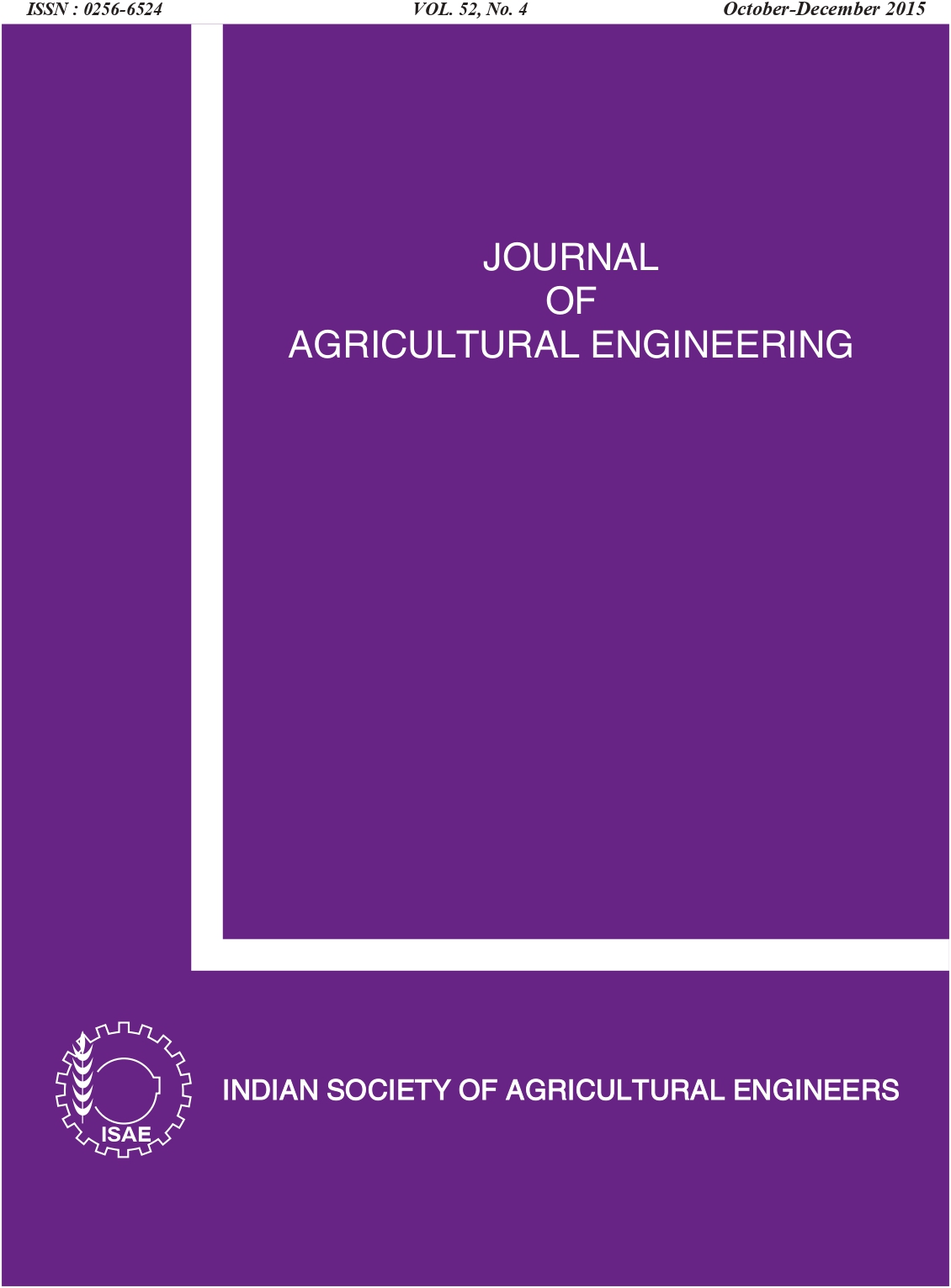Modelling of Thin-Layer Drying of Black Gram
DOI:
https://doi.org/10.52151/jae2015524.1587Keywords:
Black gram, thin layer drying, predictive model, mathematical modelling, urad beanAbstract
Thin layer drying characteristics of black gram were studied at three initial moisture contents (17.0, 21.8, 25.4% d.b), three drying air temperatures (45, 55, 65°C) and three air velocities (0.5, 1.0, 1.5 m.s-1). Drying characteristics of black gram was significantly affected by drying air temperature. Grain initial moisture content and velocity, both had a limited influence, and only during the initial stages of drying. Increase in airflow velocity greater than 1m.s-1 had no significant effect on moisture reduction. Out of the eight models evaluated, Midilli model was found to be the best fit. Effective moisture diffusivity varied from 2.96 x 10-7 to 1.08 x 10-6 m2 .s-1 and activation energy varied from 37.43 kJ.mol-1 to 48.36 kJ.mol-1 for black gram drying. The effect of air temperature and air velocity on drying constants was explained through an Arrhenius type relation, while the effect of initial moisture content on model constants could not be explained. The developed model could be used to predict the moisture ratio of black gram as affected by temperature and air velocity. Highest dehulling efficiency was found to vary between 72.3 and 72.8% when 21.8% (d.b.) initial moisture grains was dried at a temperature of 55°C.
References
Abalone R; Cassinera A; Gastón A; Lara MA. 2006. Thin layer drying of amaranth seeds. Biosystems Eng., 93(2), 179–188.
Amin MN; Hossain MA; Roy KC. 2004. Effects of moisture content on some physical properties of lentil seeds. J. Food Eng., 65(1), 83-87.
ASAE. 1993. ASAE-S352.2 Dec 92. Moisture measurementun ground seed and seeds. In: ASAE Standards 1993, 449. St. Joseph, M.I. ASAE.
Babalis SJ; Belessiotis VG. 2004. Influence of the drying conditions on the drying constants and moisture diffusivity during the thin-layer drying of figs. J. Food Eng., 65(3), 449-458.
Chandra PK; Singh RP. 1995. Applied numerical methods for food and agricultural engineers. CRC Press, Boca Raton, FL, 163–167.
Crank J. 1975. The Mathematics of Diffusion. Second ed., Oxford University Press, London, UK.
Erbay Z; Icier F. 2010. A review of thin layer drying of foods: theory, modeling, and experimental results. Crit. Rev. Food Sci. Nutr., 50(5), 441-464.
Ertekin C; Yaldiz O. 2004. Drying of eggplant and selection of a suitable thin layer drying model. J. Food Eng., 63, 349–359.
Gowda NN A; Alagusundaram K; Abirami KCV. 2014. Mathematical modeling of thin layer drying characteristics of red gram (Cajanus cajan). Trends Biosci., 7(14), 1787-1792.
Haghighi K; Segerlind IJ. 1988. Modeling simultaneous heatand mass transfer in an isotropic sphere – a finite elementapproach. Trans. ASAE, 31 (2), 629–637.
Henderson SM. 1974. Progress in developing the thin layer drying equation for maize. Trans. ASAE, 17.
Henderson SM; Pabis S. 1962. Drying theory: IV. The effect of airflow rate on dryin index. J. Agric. Eng. Res. 7, 85.
Hii CL; Law CL; Cloke M. 2009. Modeling using a new thin layer drying model and product quality of cocoa. J. Food Eng., 90(2), 191-198.
Jayas DG; White NDG. 2003. Storage and drying of grain in Canada: low cost approaches. Food Control, 14, 255–261.
Kaymak‐Ertekin F. 2002. Drying and rehydrating kinetics of green and red peppers. J. Food Sci., 67(1), 168-175.
Khatchatourian OA. 2012. Experimental study and mathematical model for soya bean drying in thin layer. Biosystems Eng., 113, 54 -64.
Khazaei J. 2008. Natural drying characteristics of sesame seeds. Cercetări Agronomice în Moldova, 41(3), 135.
Lewis WK. 1921. The rate of drying of solid materials. I&EC-Symposium of Drying, 3(5), 42.
Madamba PS; Driscoll RH; Buckle KA. 1996. The thin layer drying characteristic of garlic slices. J. Food Eng., 29, 75–97.
Midilli A; Kucuk H. 2003. Mathematical modelling of thin layer drying of pistachio by using solar energy. Energy Conver. Manage., 44, 1111–1122.
Mohapatra D; Rao PS. 2005. A thin layer drying model of parboiled wheat. J. Food Eng., 66, 513–518.
Ndukwu MC. 2009. Effect of drying temperature and drying air velocity on the drying rate and drying constant of cocoa bean. Agric. Eng. Int. CIGR J., 11, 1091.
Nuh DN; Brinkworth BJ. 1997. A novel thin-layer model for crop drying. Trans. Am. Soc. Agric. Eng., 40, 659–669.
Overhults DG; White GM; Hamilton HE; Ross IJ. 1973. Drying soybeans with heated air. Trans. ASAE, 16(1), 112–113.
Pabis S; Jayas DS; Cenkowski S. 1998. Grain Drying: Theory and Practice. New York, NY: John Wiley, pp: 303.
Page GE. 1949. Factors influencing the maximum rate of air drying shelled corn in thin-layers. Unpublished M.S. Thesis, Purdue University, West Lafayette, Indiana.
Panchariya PC; Popovic D; Sharma AL. 2002. Thinlayer modelling of black tea drying process. J. Food Eng., 52, 349–357.
Prasad S. 1979. Development of stress cracks in paddy grain during drying. Unpublished Ph.D. Thesis, Post- Harvest Technology Centre, IIT, Kharagpur, India.
Rafiee S; Keyhani A; Sharifi M; Jafari A; Mobli H; Tabatabaeefar, A. 2009. Thin layer drying properties of soybean (Viliamz cultivar). J. Agric. Sci. Technol., 11, 289-300.
Shepherd H; Bhardwaj RK. 1988. Thin layer drying of pigeon pea. J. Food Sci., 53(6), 1813-1817.
Singh SK; Agarwal US; Saxena RP. 2004. Optimization of process parameters for milling of green gram (Phaseolus aureus). J. Food Sci. Technol., 41(2), 124–130.
Tabatabaee R; Jayas DS; White NDG. 2004. Thin-layer drying and rewetting characteristics of buckwheat. Can. Biosyst. Eng., 30, 3.19-3.24.
Tiwari BK; Jagan Mohan R; Vasan BS. 2008. Effect of several pre‐treatments on the physical characteristics of dehulled fraction of pigeon pea (Cajanus cajan L). Int. J.Food Sci. Technol., 43(8), 1458-1463.
Tiwari BK; JaganMohan R; Vasan BS. 2007. Effect of heat processing on milling of black gram and its end product quality. J. Food Eng., 78(1), 356-360.
Wang CY; Singh RP. 1978. A single layer drying equation for rough rice. ASAE Paper No. 3001.
Yang W; Jia C; Siebenmorgen TJ; Cnossen AG. 2003. Relationship of kernel moisture content gradients and glass transition temperature to head rice yield. Biosyst. Eng., 85,467–476.
Zogzas NP; Maroulis ZB; Marinos-Kouris D. 1996. Moisture diffusivity data compilation in foodstuffs. Drying Technol., 14(10), 2225–2253.














